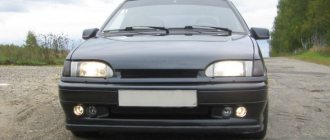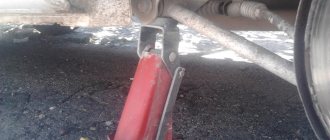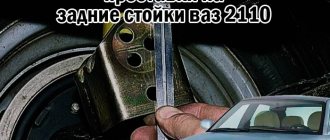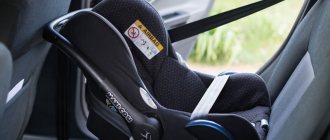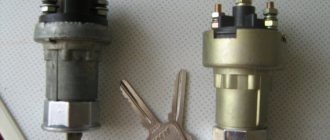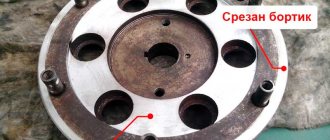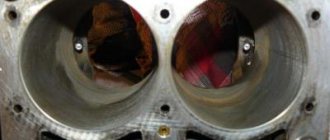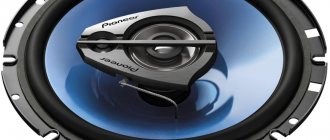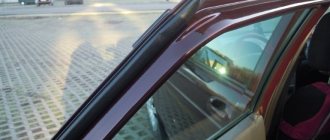Bright headlights are the motorist's main assistants in the fight against bad weather and evening twilight. They should illuminate the road well so that you can be confident while driving even in the thickest fog. But if the light provided by standard headlights is not enough for you, we recommend installing fog lights on the VAZ 2107 for better visibility. You can do this yourself without resorting to the help of specialists. We will describe in detail below how to install correctly and how to choose “lanterns”.
Requirements for installing fog lights
It is permissible to locate fog lamps directly in the headlights.
The rules for installing headlights are regulated by two regulations:
- GOST 8769-75 or SEV standard 4122-83;
- state standard of the Russian Federation GOST R 41.48-2004, corresponding to UNECE Rules No. 48.
Location of fog lights on a car
The general requirements are as follows:
- The installation location is located at a distance of no more than 400 mm from the side surface of the vehicle body. The distance is measured between the side plane and the outside of the headlight.
- It is permissible to install only two fog lights. The standards separately stipulate the mandatory installation of fog lights on tourist buses, as well as on vehicles operated on mountain roads.
- The lower edge of the fog lighting device is located at a distance of at least 250 mm from the road surface.
- Fog lights should have a horizontal viewing angle ranging from +15º to -10º, and a vertical viewing angle from +45º to -10º. It is unacceptable to block the headlights with vehicle parts within the specified angles.
- Fog lights must be connected in parallel with side lights.
- The lenses of the fog lamps must produce a beam of light located below the flow given by the low beam lamps.
- It is acceptable to use transparent filters or selective yellow color. It is unacceptable to use glass of different colors on the same car.
The standards do not have special requirements for installing fog lights on a car, so the owner can install the kit himself.
PTF VAZ 2101, 2106, 2107 CLASSICS
Detailed installation and connection of fog lights on VAZ classics
I bought components: 1 - relay. 2 — block for the relay assembly. 3 - fuse holder. 4 - PTF 2105 switch.
Installation
We pull the wiring where possible so that it is not visible and hide what is not needed. We pull the wires into the interior.
pull-pull... pulled out
everything is already connected... below you will see the diagram
Relay circuit
here she is - my dear!
By the way, I found 2 male terminals just on the PTF.
Installing the PTF on the bumper and checking I drilled the bumper with a No. 10 drill. Screwed it directly to it. I retreated 170 mm on each side and attached it.
well yes... they stick out
everything is installed!
turned on... checked
PTF DLAA LA-333T W and rear PTF VAZ 2106
In connection with the law on driving with the neighbor always on, it is reasonable to install less voracious lighting. During the day, driving is allowed with the PTFs turned on. I decided to install this device for myself.
Rear parking with a tinted rear window is problematic; this problem is partially solved by installing a rear PTF.
I bought Chinese fog lights DLAA LA-333T W. I bought the fog lights, and not the additional low beam ones, maybe it will help in rain, fog or snow. I took the Chinese ones because I spent 1.5k rubles on normal ones and they are kind of huge, they won’t fit under the bumper, and it wouldn’t be a shame to kill them on a curb or a snowdrift.
PTF.
According to GOST, front PTFs should be located at least 25 cm from the ground and no further than 40 cm from the edge of the vehicle. I got it right off the ground. I placed the mount exactly in the middle between the fang and the corner of the bumper. I screwed each PTF onto one bolt, and hung the negative wire on it. For wiring, I used a suitable drill to drill a hole in the front panel on the left under the L-shaped corrugation of the door.
Corrugation for wiring.
Front PTF.
It was logical to fasten the wires under the bumper to the wiring clamps, which are under the bolt, and screw them to the license plate on that side, but I didn’t have them at hand, I’ll install them later.
Extract from GOST on installation of front PTF
Front fog lamp
1). Installation Optional on vehicles, prohibited on trailers. 2). Number Two. 3). Installation diagram There are no special instructions. 4). Placement - Width - That point on the visible surface in the direction of the reference axis which is furthest from the median longitudinal plane of the vehicle shall be no more than 400 mm from the edge of the overall width of the vehicle. — In height - no less than 250 mm above the ground surface and no more than 800 mm above the ground surface for vehicles of category M_1. For vehicles of other categories, the maximum height is not limited. However, no point on the surface visible in the direction of the reference axis shall be higher than the highest point on the surface visible in the direction of the reference axis of the low beam headlamp. — Along the length — in front of the vehicle. This condition is considered to be satisfied if the emitted light does not interfere with the driver either directly or indirectly through reflection from rear-view mirrors and/or other reflective surfaces of the vehicle. 5). Geometric visibility Determined by vertical alpha and horizontal beta angles (2.13): alpha = 5° up and down, beta = 45° outward and beta = 10° inward. 6). Orientation The orientation of the front fog lamps should not change depending on the steering angle. Headlights must be directed forward, but not dazzle or create unnecessary inconvenience to drivers of oncoming vehicles and other road users. 7). Functional electrical circuit Must be capable of turning the front fog lamps on and off independently of the high beam, low beam or any combination thereof. The functional electrical circuit must be such that the high beam, low beam and front fog lamps can only be switched on if the lights referred to in 5.11 are also switched on. However, this requirement does not apply to high and low beam headlamps when the emission of light warning signals is achieved by periodically or alternately switching on the headlights for short periods of time. 8). Tell-tale The tell-tale is mandatory. Functions as an independent non-blinking warning signal. 9). Other requirements None.
I bought the rear PTF at a disassembly for a VAZ 2106, factory-made, screwed it into a regular place, there are already holes in the bumper for it. I put the wiring into a tube and used the cap from the 2106 choke button to attach it to the body.
Rear PTF wiring.
Rear PTF.
“Extract from GOST on installing rear PTF.”
Rear fog light
1). Installation Required. 2). Number One or two. 3). Installation diagram There are no special instructions. 4). Placement - Width - If there is only one rear fog lamp, it must be located on the left side of the vehicle's median longitudinal plane, and the origin may be located on the vehicle's median longitudinal plane. - Height - not less than 250 mm and not more than 1000 mm above ground level. For vehicles of category N_3G (all-terrain), the height can be increased to 1200 mm. - Length - behind the vehicle. 5). Geometric visibility Determined by the angles alpha and beta (see 2.13). Vertical angle alpha = 5° up and down. Horizontal angle beta = 25° right and left. 6). Direction Back. 7). The functional electrical circuit must be such that: - the rear fog lamp(s) can only be switched on if the high and low beam headlights or front fog lamps are switched on; - the rear fog light(s) could be turned on independently of any other light; — one of the following provisions applied: a). The rear fog light(s) may remain on until the side lights are turned off, after which the rear fog light(s) must remain on. turned off until it is turned on again; b). If the rear fog light switch is in the "on" position, then regardless of whether the lights mentioned in 6.11.7.1 are turned on, in cases where the ignition is turned off or the ignition key is removed and the driver's door is open, in addition to the mandatory warning light (6.11 .8) at least an audible warning signal must be given; — Except as provided in 6.11.7.1 and 6.11.7.3, the operation of the rear fog lamp(s) shall not be affected by the switching on or off of any other lamp. 8). Tell-tale The turn-on telltale is mandatory. It provides an independent and non-flashing warning light. 9). Other requirements In all cases, the distance between the rear fog lamp and each brake light must be at least 100 mm.
Now the first two buttons on the dashboard are used to control the lights. Both buttons have 3 positions. The first is dimensions and light. The second is front PTFs and front PTFs with rear ones. Wiring according to GOST, i.e. Do not turn on the devices in this way, so as not to comply with the rules. PTFs are turned on only when the dimensions are turned on, and the rear PTFs must be used in conjunction with the near/far or front PTFs. All OK.
Dashboard
Connection diagram for front and rear PTFs.
Repair of fog lights Wesem HOz for VAZ 2107
I was driving along, enjoying my fog lights, and suddenly I caught a pebble from under the wheel of the vehicle in front of me. I see a hole in the fog with a radius of 100500 mm.
It was decided to repair these, but even the manufacturer of these fog lights does not have such glasses separately. The size was approximately the same as a VAZ 2106, I took 2 glasses because... A long time ago both my fog lights burst, but that didn’t stop them from shining, and I didn’t worry about it. As a result, 2 VAZ 2106 high beam glasses and a tube of transparent sealant were purchased, at home I wrapped the fogs in a rag so that they would not see their death, finished off their glass with a hammer, cleaned the surface of the reflector, degreased the surface for applying the sealant, poured the sealant, laid the glass and centered it is accurate to within hundredths of a nanomillimeter by eye. The glass turned out to be clearly centered. I poured another layer of sealant on top. Everything dried out in a couple of days. I removed the excess sealant, checked the fog lights - they shine, almost as before.
The operation was very successful. Now I don’t have to be afraid of breaking them on curbs. The repair budget was 40 rubles for a pair of pieces of glass and 60 for sealant = 100 rubles
Installation of PTF on VAZ 2107
I've wanted fog lights for a long time. Or rather, additional light for a more comfortable ride in autumn and winter. The standard Zhiguli headlights cannot be called particularly powerful, but I live in a small provincial town, where the roads are sane for a couple of months after the next repair, only the central streets are illuminated, and starting in October everything becomes black and wet. I started digging through the forums. Why the “correct” installation? Because I like everything that is done to have a “factory” appearance and an acceptable level of quality. This is especially important when working with wiring. You know the statistics, right? So that at a crucial moment you don’t have to remember how to pull the pin off a fire extinguisher, you need to do everything according to science. And very consistently. First I bought everything I needed:
Young fogman set
-Wesem HM3 headlights - 246 UAH. Polish products of good quality with real corrugated glass, strong, airtight, the right shape, and three times cheaper than Hella. True, they come without light bulbs. - H3 lamps Osram AllSeason - 63 UAH (with shipping). I bought them almost new from a guy from Kirov for half the price than in the store. He didn’t like the yellowish light—that’s exactly what I needed. All-weather lamps, just right for wet roads, fog, rain. - any 4-pin relay, for example, for turning on the low/high beam (with an eyelet for fastening) - 14 UAH. -2-position button 2105/2107 — 15 UAH. - pads for relays and keys, just for ease of installation - 3 and 5 UAH. respectively. - fuses 7.5A - 2 pcs., 15A - 1 pc. Price 1 UAH. a piece. - female terminals, 15 pieces, and 2-3 clamp terminals for ground - about 10 UAH. - assorted wires). There’s no need to hustle here, the currents are considerable, let them be at least 1.5 sq.m. in cross-section, and even 2.5 sq.m. for the relay power circuit. I took 5 meters of all kinds at once, UAH. for 40, and of course I still have most of it, so I don’t know about the money. -fasteners: M4 bolts, nuts for them, washers - another 5-6 UAH. The total revision budget is less than 400 UAH. In Russian rubles it will be about 1500. I started with the mounting block.
For convenience, remove the washer reservoir and place it on the battery. Oh, by the way, don’t forget to remove the ground terminal... We fix the relay where it’s convenient, I have this place on the right mudguard:
Let's estimate the ratio
We take out the white block Ш9. Into empty pin 1 we insert the pre-crimped end of the wire, which will go to the RIGHT fog lamp.
Ш9/1
In the same block we insert a thicker wire into contact 3 (nearby).
Ш9/3
We connect the second end of the thick wire to contact 87 of the relay. Voltage will appear on this wire when the relay winding is closed. We return the Ш9 block to its place. We take out the yellow block Ш11. It's almost empty. We need pin 8. Insert the wire. In the photo it is already inserted.
Ш11/8
We connect the second end of the wire to contact 86 of the relay. This will be the control line. We return the block Ш11 to its place. We take out the red block Ш6. We plug another thick wire into the place for contact 8, and the other end - to terminal 30 of the relay.
Ш6/8
Please note that in the photo I am holding the terminal at pin 1 - the 8th one we need is on the opposite end of the block. This wire, which supplies both PTFs, will be energized all the time when the ignition is on. We return the red block to its rightful place. Finally, we pull out the green block Ш7 and connect 1 wire from the LEFT fog lamp to the contact, as in the photo:
Ш7/1
We put the block back into the connector. Now open the cover of the mounting block itself. We look at it with a smart look :). This circuit uses 3 fuses: the general power supply to the PTF will go through F1. Its rating is 10A, but since other devices are already hanging on it, and we are going to add more load to it, it is advisable to replace it with 15 A. Fuses F3 and F4 are initially backup. Now power will go through them to each headlight individually. There they are set at 10A, well, I replaced them with 7.5A, just in case, for one 55 W light bulb this is enough. Here is a photo of the mounting block after the changes were made:
Mounting block with new fuses
We screw the remaining contact of relay 85 to ground. All other wires from the relay are already plugged into the block.
Connected relay on the mudguard
Now we pull the free ends of the wires to each headlight. How to lay them is everyone's business. I dragged along the existing harnesses, carefully grabbing them with computer ties.
Wire going to the right PTF
There are technological holes in the radiator area. After thinking, I enclosed the last piece of wire in a corrugated piece, since there would be hot metal nearby. Just in case. The ends of the wires are pulled into the holes in the apron by 25 cm, and for now we leave them hanging like that.
Corrugations with wires
Who said: “Why are there 2 headlights and 4 wires?”))) Don’t forget about MASS! For those who don’t mind the wires, you can look for the mass for the fog lights on the bumper itself, but I decided not to risk it and spent an extra meter, but screwed the mass onto the mudguards, there are convenient bolts there just for this purpose.
Installing headlights
There is no consensus here on where to put them, because... There are no regular places for them in the sevens. Most put them under the bumper, some on it, but I decided to embed them into the bumper itself. This is an extremely dreary matter, I’ll say right away, but in principle, it’s justified. Firstly, it looks beautiful (if the PTFs are of the right shape). Secondly, in this case it is difficult to break them and simply... steal them. In general, it depends on the taste and color. For those who want to kill the day, but do it beautifully, read below. We remove the bumper, trying not to knock off our fingers, as I did technically. Carefully, with a ruler, we define the boundaries of the glass, leaving a millimeter in reserve. There is no need to leave much, since we will then finish it with a file, and the bumper is sawed very slowly, even though it is plastic. We drill along the contour with a thin drill and cut out rectangles with a hacksaw blade or jigsaw.
Cutting out holes...
Next, as mentioned above, we roughly polish the edges with a file and bring them to the exact size. You'll have to sit here for a couple of hours, you won't get anywhere.
...and finish the edges with a file
We try it on, look, if it doesn’t fit, we adjust it again
The manufacturer from fraternal Poland provided brackets for my headlights, for which I thank him very much. Under them I drill 2 holes into which I insert M4 bolts with countersunk heads. This case will be closed from above with a chrome saber on the bumper. You can mount it any way you like, you just need to remember that the headlight should be adjustable, at least within small limits (a minus of this option), and it is desirable that you do not have to remove the bumper each time for this. We return the bumper to the car.
Connecting a button in the cabin
I placed the button in an unoccupied place in the beard. I had a suitable button (from an MTZ tractor), however, it had melted. I bought one for the heated rear window and replaced the button arm itself with the pictogram. The two-position button for heating or turning on the PTF with 2105 is perfect for our evil plans. If the switch has a light bulb, like mine, you need to decide whether to connect it and how best to do it. AvtoVAZ’s logic regarding the indication on these buttons is, of course, strange. On some, the indicator lights up when the dimensions are turned on (like, here I am, press me), on others it signals that the consumer is turned on, on others there is no light at all, although it would not hurt... Well, since I don’t yet have a separate indicator light for turning on the PTF, I decided to do the second option, but we’ll still consider both.
From left to right: exterior lighting block, fog light block, ZPTF block
1.Connecting the key, “indication” mode (like the non-locking key for the rear PTF lights): -contact U of the key is connected to contact T (black wire) on the rear PTF button - this will be the ground of the light bulb. -contact H of the block is connected with a jumper to contact L - “plus” of the light bulb. - contact V is connected to contact V of the three-position lighting key (yellow wire with a red stripe) - here “+” will appear when the side lights are turned on, as prescribed by GOST (PTF can only be used with the light of the main headlights) - from contact L we lay the control wire behind instrument panel to the blue block Ш4, pin 5. To do this, you will need to unscrew the beard, the glove compartment and even the controller.
Ш4/5
We check, put everything back together, and enjoy. 2.Connecting the key, “backlight” mode (like the heated rear window key) - contact U of the key is connected to contact T (black wire) on the rear PTF button - ground of the light bulb. -contact H is connected to contact V of the three-position lighting key (yellow wire with a red stripe) and from the same contact H we connect a jumper to contact V of our new button - when the dimensions are turned on, the indicator will light up and current will appear in the “working” circuit (“ready”) . -from contact L we lay the control wire to the blue block Ш4, contact 5.
Scheme
Everyone is exhausted, this is what it looks like:
Keys on the beard
Of course, there is plenty of fuss, but everything will look neat, without unnecessary “snot” and “collective farm”. Relays and fuses, in case of replacement, are conveniently located. Well, and a demo photo:
Result
I remember the first time I sat in the seven, I really liked that the buttons were all on the beard at the bottom - convenient! Even in the dark, while walking, I lowered my hand and immediately felt it. The icon on my button appears to mean "side lights" rather than "fog lights," and that's exactly what it ended up being. Due to the design features of the bumper and the PTFs themselves, they shine with a narrow and very wide beam, while having an upper limit and not blinding oncoming drivers. If, with one headlight on, you drive as if along a narrow corridor of light (there is darkness on the sides), then when you turn on the new headlights, the situation changes greatly: the full width of the road becomes visible, including the side of the road and the asphalt “under the nose” of the car. PTFs alone are, in principle, not enough for driving on dark streets, but they, apparently, are not designed for such use. The packaging indicates “additional headlights”, that is, the range of their use is wider than just in fog (which, by the way, does not happen very often.).
https://www.drive2.ru/l/288230376152467647/, https://www.drive2.ru/l/5749877/, https://www.drive2.ru/l/4899916394579202269/, https://www .drive2.ru/l/288230376152394540/#post
next article:
Side lights VAZ 2101, 2106, 2107 CLASSIC
Contents of the article: American dimensions in the VAZ 2107 Dimensions in the turn signals of the VAZ 2104 Transfer of side lights
Rating 5.00 [2 vote(s)]
What will you need to install fog lights?
To install fog lights yourself, a minimum set of tools is required. The car owner must have knowledge and skills in working with electrical wiring, since the safe operation of the car as a whole depends on the correct installation.
- color electrical diagram of the car;
- nippers or side cutters;
- wire cleaning knife;
- terminal crimping pliers (terminal block);
- soldering iron
Set of materials required for installation:
- a set of fog lights suitable for installation in standard holes in the bumper or universal ones that are mounted on the surface of the bumper;
- stranded copper wire with a cross-section of 1.5-2 mm² with insulation capable of operating at low temperatures and resistant to gasoline and oil vapors;
- relay for turning on (standard headlight turn-on relays from front-wheel drive VAZ models are usually used);
- remote housing for installing a blade fuse;
- 30 A blade fuse;
- a control key that matches the interior design (preferably with a backlight);
- connectors and terminals for connecting wires to circuit elements;
- heat shrink tube of suitable diameter;
- electrical tape on a polyethylene or fabric basis;
- plastic ties;
- automotive corrugated hose for laying wires.
Set of fog lights for Ford Focus 3
Price list
- Special offers
- KAMAZ spare parts
- Spare parts KAMAZ-5490
- Spare parts MAZ, YaMZ
- ZIL spare parts
- Spare parts ZMZ, for GAZ vehicles
- Spare parts for Volzhanki cars
- Spare parts for Gazelists
- Spare parts for trucks Lawns
- Spare parts for GAZ-71 caterpillar
- Spare parts UAZ, UMZ
- Spare parts KrAZ, BelAZ
- Spare parts URAL
- Spare parts BUSES
- AMAZ spare parts
- IKARUS spare parts
- KAVZ spare parts
- LAZ spare parts
- LIAZ spare parts
- NEFAZ spare parts
- PAZ spare parts
- Other buses
- Tractors, computer equipment, attachments
- Tractors and walk-behind tractors
- Municipal vehicles
- Attachments and trailed equipment
- Spare parts for TRACTORS and SPECIAL EQUIPMENT
- JCB - spare parts for special equipment
- Truck crane (KS-3577, KS-4517, etc.)
- AMZ (A-01, A-41, D-440, D-442, D-447, D-461, D-467)
- Amkodor (TO-18, TO-28, TO-30, etc.)
- ATZ (T-4A, TT-4M)
- VgTZ (DT-75)
- VMTZ (D-120, D-144, D-130, D-145T)
- VTZ (T-25, T30A-80, VTZ-2048)
- LTZ (T-40, LTZ-55, LTZ-60)
- MKSM, UNC, DETVAN
- MTZ - spare parts for tractors
- OTZ (TDT-55)
- PTZ (K-700/701/702/703/704)
- KhTZ (T-150, MT-LB)
- ChTZ (T-130, T-170, B-10, B-12, B-170, T-10M, DET-250)
- YuMZ - spare parts for tractors
- Other special equipment and tractors
- RVD - high pressure hoses and sleeves
- MMZ spare parts and engines
- Spare parts for MMZ engines
- MMZ engines: D-242, D-243, D-245, D-246, D-260
- VAZ spare parts
- Spare parts OKA VAZ 1111
- Spare parts VAZ classic 2101 - 2107
- Spare parts VAZ front wheel drive
- Spare parts VAZ Granta and Largus
- NIVA spare parts and all-wheel drive
- Spare parts Moskvich, IZH
- Spare parts for Korean trucks
- Spare parts for Starex, H-1
- Spare parts for Porter, H-100
- Spare parts for HD65,72,78, County
- Spare parts for HD120, AeroTown
- Spare parts for HD160,170, . ,700,1000
- Spare parts for HYUNDAI, KIA buses
- Spare parts for Korean passenger cars
- Spare parts DAEWOO, CHEVROLET
- FOREIGN CAR spare parts more
- BMW spare parts
- DAF spare parts
- FIAT spare parts
- FORD spare parts
- Spare parts HONDA, ACURA
- IVECO spare parts
- MAN spare parts
- MAZDA parts
- MERCEDES spare parts
- MITSUBISHI spare parts
- Spare parts NISSAN, INFINITI
- OPEL spare parts
- Spare parts PEUGEOT, CITROEN
- RENAULT spare parts
- SCANIA spare parts
- SHAANXI spare parts
- SSANGYONG spare parts
- SUZUKI parts
- Spare parts TOYOTA, LEXUS
- VAG spare parts: VW, AUDI, SEAT, SKODA
- VOLVO spare parts
- Other foreign cars
- Trailers and semi-trailers
- SEMI TRAILERS foreign
- Domestic SEMI-TRAILERS
- TRACTOR TRAILERS
- Passenger TRAILERS
- Towbars and spare parts for passenger trailers
- Car audio and navigation
- Antennas
- DVRs
- Automotive video equipment
- Memory cards, flash drives
- Speakers, subwoofers, acoustics
- Accessories
- Radio tape recorders
- FM modulators, MP3 players
- Navigation, parking systems
- Radar detectors, antiradars
- Radio stations and accessories for them
- Sound amplifiers
- Auto chemical goods, filters
- Car cosmetics, paints, care products
- Auto chemicals, liquids, additives, antifreeze
- Household chemicals, gas
- Oil
- Lubricants, liquid wrenches
- Other means and fuels and lubricants
- Filters and elements
- Rechargeable batteries
- Batteries for motorcycles (up to 30 A/h)
- Batteries for cars (up to 125 A/h)
- Batteries for trucks (from 125 A/h)
- Accessories and tuning
- AvtoLady - products for women
- Breathalyzers
- First aid kits, fire extinguishers, emergency signs
- Car racks
- Gas equipment
- Car mirrors and elements for them
- Air ionizers
- Carpets, trunk mats
- Steering wheels, covers and gear knobs
- Compressors, pumps, hoses
- Seats, cushions, belt adapters
- Literature, catalogs
- Organizers, luggage securing
- Alarms, blockers, sirens
- External tuning
- Tuning internal
- Car refrigerators
- Anti-skid chains
- Seat covers, headrests
- Windshield wiper blades and strips
- Velo, moto, quad bikes
Connection diagram
For installation, two connection schemes for fog lights are possible:
When connected in parallel, the positive wire goes to each headlight from the relay contact. Power to the relay is supplied through a fuse link with a rating of 15 A, which is enough for most models of fog lights. It is advisable to place the fuse as close to the battery terminal as possible.
The +12V signal voltage should appear only when the ignition is active. This measure prevents the headlights from working when the engine is off. If desired, you can automatically ignite the headlights after turning on the ignition. To do this, the signal wire is connected to the battery charging indicator lamp installed in the instrument cluster. The button must be on.
Parallel connection
Serial connection reduces current consumption and lamp brightness. A similar scheme is used to use fog lights instead of standard headlights.
Serial connection
Connecting additional headlights via a relay is demonstrated in the video tutorial from the “AUTO ELECTRICAL — Steel Horse” channel.
Video
The wiring diagram for installing fog lights is shown in a video filmed for the “Car Lover” channel.
Bright headlights are the motorist's main assistants in the fight against bad weather and evening twilight. They should illuminate the road well so that you can be confident while driving even in the thickest fog. But if the light provided by standard headlights is not enough for you, we recommend installing fog lights on the VAZ 2107 for better visibility. You can do this yourself without resorting to the help of specialists. We will describe in detail below how to install correctly and how to choose “lanterns”.
Reversing light
A reversing light is not mandatory, however, its use can significantly increase the safety of the car. This light device is activated when reverse gear is engaged and performs the following functions:
- illumination of a section of the road and objects located behind the car when reversing in the dark;
- informing other road users that the vehicle is moving in reverse.
The principle of operation of the reversing light is based on the closure of the electrical circuit into which the reversing lamps are connected when the ignition and reverse gear are turned on. The closure occurs using the so-called “frog” installed on the gearbox.
Fuse F1 is connected to the reversing light circuit, which is also responsible for the heater motor, rear window cleaner and washer.
What it is?
Already from the name it becomes clear that these headlights were invented specifically so that motorists could clearly see the road in fog or, for example, snowfall. The fact is that they are located very close to the road surface, where the fog is not very thick. Thus, they can easily penetrate it with their light and improve visibility around. They are not afraid of the most unexpected vagaries of nature, so those who often drive a car simply need them.
It is worth noting that such headlights will not only improve your car, but will also make it look different from other VAZ 2107, since fog lights were not intended by the manufacturer as standard elements on this car. Such tuning greatly decorates the car and makes it noticeable.
Which ones to choose?
As we have already said, fog lights are not only an important part of the car, but also its decoration. Thus, their choice must be approached responsibly.
First decide on the design and color of the light. You can choose round or square, yellow light or white. A wide range is offered by such companies as Osvar, Wesem, Hella, Catz and Osram.
The pricing policies of these brands are different, but you should assume that the more expensive the headlights, the better they are. Please note that the larger its surface, the brighter it will shine. That is why it is best to choose the largest size models from all those presented in the store.
In addition, we advise you to immediately purchase bulbs for them of the required category (H1, H2, H3, H7 or others) with a power of no more than 55 watts, so as not to blind drivers of oncoming cars and not to overheat the relay.
Preparing for work
Once you have purchased the headlights you like, you can begin installation. Materials we will need:
- Female connector.
- Wiring.
- Four-stroke standard relay.
- On/Off button.
If possible, it is best to purchase a special kit for connecting fog lights on a VAZ 2107.
To make the work more convenient, we recommend removing the bumper from the car before starting the process, since the fog lights should be installed under it. Please note that according to GOST, the lamps must be located under the low beam headlights and no lower than 25 cm from the road surface.
Also check out
It is likely that the headlights will need to be adjusted upon completion of the work.
In the following photographs you can see how to connect fog lights on a VAZ 2107.
The working process
We select the desired location and use a drill to drill holes for the bolts on which the foglights will be attached. Place the relay on the right side of the engine compartment. It should be connected to the wire located next to the splash guard. Now connect the relay to the new headlights.
We form a bundle from two wires coming from the left and right fog lights so that the wires do not dangle and interfere. Then we drill three holes in the bumper and secure the flagellum with wire.
We screw the headlight mounts to the bumper, then put it in place. We disassemble the lanterns and insert pre-purchased light bulbs into them.
Now let's hang the back parts of the foglights. First, we thread the connected wires into the left headlight, strip them, and crimp the connectors. Now you can connect a light bulb to them and assemble it completely. We perform the same actions with the right one, but in addition we additionally crimp the parallel power supply and the harness onto the left fog lamp.
